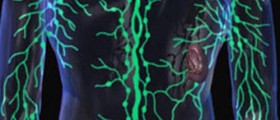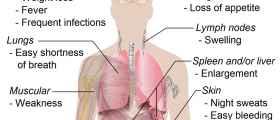
Hodgkin’s disease is a type of cancer known as lymphoma. It is also called Hodgkin’s lymphoma. Hodgkin’s disease is a cancer of lymphatic system and begins in lymphocytes (white blood cells).
Hodgkin’s Disease OverviewHodgkin’s disease affects the lymphatic system, which is a part of the immune system. The lymphatic system protects the body against infectious diseases by fighting off different pathogens and unwanted substances.
The lymphatic system consists of lymph vessels that connect other organs of this system, the spleen, thymus, tonsils, bone marrow and lymph nodes or lymph glands. The lymph vessels carry the lymph, a clear fluid composed of lymphocytes.
The lymph nodes are bean-shaped organs and they filter antigens that invade the body. The lymph nodes are found in clusters in the groin, neck, abdomen, armpits and other locations.
Hodgkin’s disease occurs when cells in the lymphatic system grow and divide uncontrollably and spread beyond this system.
Causes of Hodgkin’s DiseaseThere are two main types of lymphoma, non-Hodgkin’s lymphoma (common type) and Hodgkin’s disease. Hodgkin’s disease is a rare cancer and is most often diagnosed in people under the age of 35 and above the age of 55.
The exact cause of this cancer is unknown. However, there are several risk factors for Hodgkin’s disease including a family history of the disease, history of infection with Epstein-Barr virus, weakened immune system and male gender.
Symptoms of Hodgkin’s Disease
Hodgkin’s disease begins in lymph nodes and the primary symptom of the disease is painless enlargement of one or more lymph nodes in the neck, armpit or groin. Night sweats, fatigue, fever and chills that come and go and unexplained weight loss can be also exhibited.
In the early stage of Hodgkin’s disease the patients may also experience itchy skin (pruritus). Enlargement of the spleen or liver, or both and back pain may also be present. All of these symptoms are not specific, but if swelling of the lymph nodes persists over six weeks and does not respond to treatment with antibiotics, it typically indicates Hodgkin’s disease.
Diagnosis of Hodgkin’s Disease
To diagnose Hodgkin’s disease, a doctor will perform a physical examination to check for swollen lymph nodes. To confirm the diagnosis, the doctor will order a lymph node biopsy. A stage of the disease can be determined with tests and procedures such as blood test, x-ray, CT scan, MRI scan, PET scan and a bone marrow biopsy.
Treatment for Hodgkin’s Disease
Hodgkin’s disease is treated with combination chemotherapy. Commonly used chemotherapy regimen is ABVD which includes four drugs administered intravenously. Stage I and stage II are additionally treated with radiation therapy. Bone marrow transplant is used in case the cancer returns after the treatment.
Prevention of Hodgkin's Disease
Unfortunately, there are no known means of preventing Hodgkin's disease. The only thing that can be done is to pay close attention to people at higher risk for this type of cancer, particularly if there is noticeable lymph node enlargement. This way the lymphoma can be timely diagnosed and treated with more success.
















Your thoughts on this
Loading...